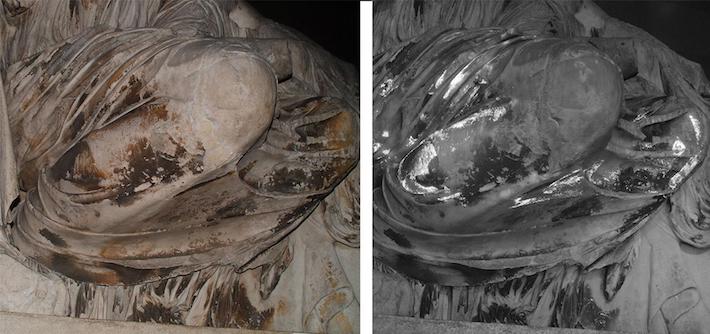 CHICAGO, ILLINOIS—Live Science reports that a new examination of the Parthenon Sculptures housed in the British Museum using luminescence imaging has revealed traces of ancient paint. Giovanni Verri of the Art Institute of Chicago and his colleagues mapped the elements on the carvings, and detected floral designs and smudged figures. The team identified several types of pigment on the sculptures: Egyptian blue, purple made with an unknown recipe, and two types of white, one made with gypsum and the other with bone ash. Evidence of paint on the backs of the sculptures suggests they were decorated before being installed in the Parthenon, the temple built on the Athenian Acropolis in the fifth century B.C. and dedicated to the Greek goddess Athena. “The elegant and elaborate garments were possibly intended to represent the power and might of the Olympian gods, as well as the wealth and reach of Athens and the Athenians, who commissioned the temple,” Verri said. The Parthenon was damaged by warfare in the seventeenth century, and then, in the early nineteenth century, about half of the surviving sculptures were removed by Thomas Bruce, the seventh Earl of Elgin and Britain’s ambassador to the Ottoman Empire, which ruled Greece at the time. Elgin went on to sell the collection to the British government. To read in-depth about efforts to restore the Parthenon and its neighboring structures, go to "The Acropolis of Athens."
CHICAGO, ILLINOIS—Live Science reports that a new examination of the Parthenon Sculptures housed in the British Museum using luminescence imaging has revealed traces of ancient paint. Giovanni Verri of the Art Institute of Chicago and his colleagues mapped the elements on the carvings, and detected floral designs and smudged figures. The team identified several types of pigment on the sculptures: Egyptian blue, purple made with an unknown recipe, and two types of white, one made with gypsum and the other with bone ash. Evidence of paint on the backs of the sculptures suggests they were decorated before being installed in the Parthenon, the temple built on the Athenian Acropolis in the fifth century B.C. and dedicated to the Greek goddess Athena. “The elegant and elaborate garments were possibly intended to represent the power and might of the Olympian gods, as well as the wealth and reach of Athens and the Athenians, who commissioned the temple,” Verri said. The Parthenon was damaged by warfare in the seventeenth century, and then, in the early nineteenth century, about half of the surviving sculptures were removed by Thomas Bruce, the seventh Earl of Elgin and Britain’s ambassador to the Ottoman Empire, which ruled Greece at the time. Elgin went on to sell the collection to the British government. To read in-depth about efforts to restore the Parthenon and its neighboring structures, go to "The Acropolis of Athens."
Traces of Colorful Paint Detected on Parthenon Sculptures
